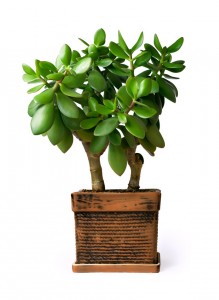
Jade plant. (C) Fotolia.com
If you haven’t done so already, start moving houseplants that spent the summer outdoors back inside. Night temperatures in the 50s are the signal.
First, though, examine the plants for insects. Be sure to check under the leaves and along stems.
Next, give the plants a good shower with the hose to wash off any dirt and insects. Be sure to spray the under sides of leaves. If a hose is not convenient, give plants a shower in the tub or kitchen sink.
Be prepared for some possible leaf drop when your plants are moved indoors, where they will get less ambient light. You can minimize this by acclimating the plants in the brightest windows of your home for a week or two before placing them about. Some plants, such as weeping fig (Ficus benjamina), are going to drop their leaves no matter what. They usually grow new ones pretty quickly.
J.O.B of Indianapolis says her four-year-old jade plant (Crassula ovata) usually spends summers outdoors, but this year, it “has lost lots of leaves and has developed silver patching on existing leaves. I did repot it this summer, as I believed it had become pot bound. And just this week, I lost a large arm of the plant. What am I doing wrong?”
The excessive Indiana heat likely stressed the plant, opening it up for problems, so the silver patches could be thrips, says Julie Bawden Davis, a garden-writing colleague at the Healthy Houseplants Web site.
 “Examine the leaves with a hand lens or magnifying glass, looking for thrips. They’re small, long-bodied insects with wings. Isopropyl alcohol, insecticidal soap and neem are good treatments,” says Davis, author of Indoor Gardening the Organic Way.
“Examine the leaves with a hand lens or magnifying glass, looking for thrips. They’re small, long-bodied insects with wings. Isopropyl alcohol, insecticidal soap and neem are good treatments,” says Davis, author of Indoor Gardening the Organic Way.
Jade plants like to be pot bound, she said. When transplanting any houseplant, the new pot should only be one or two inches larger, such as from a six-inch pot to an eight-inch pot.